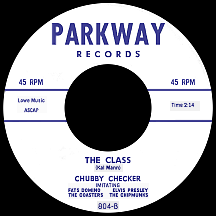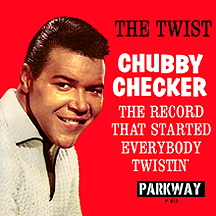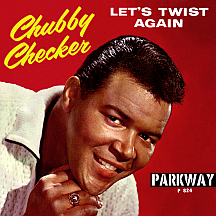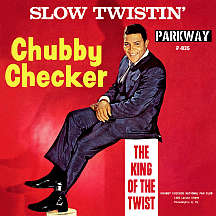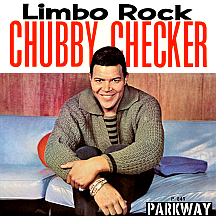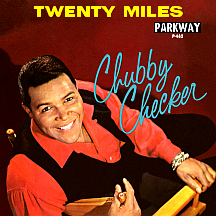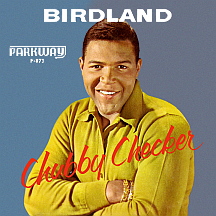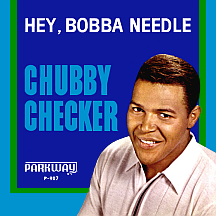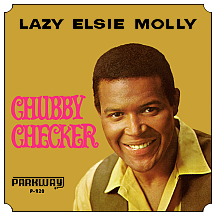CHUBBY CHECKER
In 1959, Detroit-based singer-songwriter Hank Ballard introduced "The Twist." He wasn't the first to come up with such a body-gyrating move; similar dances had existed for years, decades even, maybe centuries. While he supplied the name, it was the teenagers of the late '50s who popularized the dance he'd envisioned. The Buddy Deane Show, a weekday after school dancefest on Baltimore's channel 13, WJZ-TV, has been credited as the place where the Twist was first seen. Shortly afterwards, Dick Clark of Philadelphia's American Bandstand (airing nationally on ABC-TV), having taken note of the fresh new trend, made a suggstion to the city's top record company, Cameo-Parkway, that a cover version of Ballard's song with a promotional push (including featured spots on Bandstand) might catch on coast to coast. Chubby Checker, who'd already chalked up a classroom-set top 40 hit, was called in to give it a go.
Spring Gully, South Carolina native Ernest Evans had moved to South Philly with his family in the late '40s and by 1958, at the age of 17, he'd found work in a poultry shop, where he sang and did celebrity impressions while waiting on customers. Kal Mann and Bernie Lowe of Cameo Records, who were occasional customers, took notice. The relatively new label had already scored hits in 1957 by Charlie Gracie ("Butterfly") and The Rays ("Silhouettes"); both acts had made appearances on Bandstand. When Clark found out about the teenager who did impressions of popular singers, he asked Mann and Lowe if he would do a special project for him: a record to give to friends and relatives as a recorded Christmas card. Ernie jumped at the chance and Dick's wife, Barbara Clark, who was in the studio when it was made, after hearing Evans' Fats Domino impression, saw him as a "Little Fats Domino," then suggested the Chubby Checker name by which he's now famously known.
As a result, Mann and Lowe signed Evans to Parkway and his first recording, "Schooldays, Oh, Schooldays" (an upbeat homage reminiscent of Louis Jordan's 1950 hit "School Days"), appeared under the Checker moniker with a crazy parody of current hitmakers on the flip side. "The Class" showcased his knack for mimicry, taking on the roles of both teacher and students singing variations of "Mary Had a Little Lamb" as Domino, The Coasters, Elvis Presley, The Chipmunks and drummer Cozy Cole. In June of '59, the novelty tune reached the top 40. More silly songs followed ("Whole Lotta Laughin'," "Dancing Dinosaur"), prior to Chubby's career-defining dominance.
As with Ballard's early hits with The Midnighters (1954's "Work With Me Annie," "Sexy Ways" and others), his Twist contained a sexual double entendre. Checker treated it purely as a dance, sometimes setting it up with instructions, such as "putting out a cigarette with your feet and wiping off your bottom with a towel" (early rock era dances abandoned traditional couples-based movements; "The Stroll," a 1958 sensation perpetrated by The Diamonds' hit, was a line dance, while "The Twist" was designed to have no bodily contact). By the summer of 1960, with help from airplay and personal appearances on Bandstand, the dance hit its initial peak (there would be another) as Ballard's version on King Records, which had previously achieved a top 20 ranking on the R&B charts in the spring of '59, returned and climbed to the top ten after more than a year's hiatus; it landed on the pop charts in July 1960, only to be leapfrogged by Checker's rapidly-developing cover. Ballard's original reached the Hot 100's top 30 (suggesting there were radio stations, and fans, that preferred his version) just as Checker took the song to number one in mid-September.
The summer-fall success of Chubby's "Twist" led to more dance records: "The Hucklebuck" (written by seasoned jazz trumpeter Andy Gibson and lyricist Roy Alfred, it was a hot dance in the late '40s popularized by Tennessee-born jazz saxophonist Paul Williams, Frank Sinatra and others) placed Checker in the top 20 in November (its also-popular flip was a remake of Jerry Lee Lewis's "Whole Lotta Shakin' Goin' On"). A cover of "Pony Time" (a 1961 dance recording by Don Covay and his group The Goodtimers) sent Checker back to number one in February 1961, establishing him further as the "King of the Dance Records." Then came "Dance the Mess Around," a vaguely-conceived concept, flipped with a breakneck-paced cover of James Brown's "Good, Good Lovin'" (these early hits featured backing vocals by The Dreamlovers, who later reached the top ten with "When We Get Married").
Then came the "33 Compact Double" snafu, an effort by some of the larger record companies to supersede the large-hole 45 RPM format with a small-hole 33 RPM disc that would have more playing time and, sometimes, stereo sound (at a higher price, of course). But 45s had become the domain of an extensive teenage buying public unwilling to upgrade (if that's the right word) to a more expensive alternative. One failed release had followed another over the previous year or so...with the exception of one RCA Victor extended play, Elvis by Request, which included his hit movie theme "Flaming Star," which posted decent sales, though below that of a typical Presley 45.
Following RCA's lead, Parkway issued a "test" EP (a shorter-titled "Mess Around" its priority track) in the 33 "double" format (just another term for EP) with low expectactions (Columbia went so far as to admit the format's failure publically yet curiously continued pressing and promoting the 33 RPM singles through the mid-'60s). The good news for Cameo is that they didn't prolong the suffering in trying to market 33 RPM discs like other labels did for two or three years (or in Columbia's case a half-decade). They weren't about to purposely decelerate the blazing-hot momentum of their top-selling artist by giving buyers an excuse not to buy his records. Even when priced lower, people weren't embracing these so-called Compact 33s. All the record labels eventually discontinued the small-hole singles for purchase in stores, though the format continued to be pressed for use in juke boxes.
But the regular-sized 33 RPMs were a different story! While each of Chubby's 45s reached a high position on the charts, his albums were hot sellers, led by Twist With Chubby Checker. A year into the Twist phenomenon, people were still doing the dance wherever he performed. Kal Mann took notice and, instead of writing a song about another dance, penned "Let's Twist Again" ('...like we did last summer...'), which added to C.C.'s growing list of top tens in July '61. Right on its heels came another dance track, "The Fly," that followed the set pattern, reaching the top ten in November. By this time, a shift had occurred: the dance craze began impacting New York society as Joey Dee and the Starliters' residency at the Peppermint Lounge nightclub drew crowds lined up around the block, including celebrities that were given the V.I.P. treatment, fueling the society columns and piquing interest in what had become a phenomenon. The parents and other 30-plus "old-timers" had discovered what the teenagers had already known for a year (or two)!
While not-so-chunky Chubby joined Bobby Rydell for a remake of Bobby Helms' seasonal smash "Jingle Bell Rock," "The Twist" was suddenly the focus of many dance parties where martinis were served. In November, the single (with its new flip "Twistin' U.S.A." replacing previous B side "Toot") reappeared on the charts, climbed faster than it had the first time, and returned to the top ten the first week in December. This time it had competition from Dee's rapidly-rising "Peppermint Twist" and the race was on. Checker's song reached number one again in mid-January, just the second song in recorded music history to pull off the feat after Texas-born opera, pop and country singer Vernon Dalhart's hit "The Prisoner's Song," which spent several weeks at number one in the spring of 1925, then fell off the charts for four months before returning to the top spot for several more weeks through February 1926.
Columbia Pictures' Twist Around the Clock, released at the end of December (featuring performances by Checker, Dion and The Marcels), was a hot ticket at the cinema, competing against Paramount's Hey, Let's Twist starring Joey Dee, whose "Peppermint Twist" disc managed to knock Checker off his chart perch at the end of January as millions of twisters were euphorically caught up in rock and roll's hottest trend. They were joined by a crowd of bandwagon-jumping hitmakers in those early months of '62 (The Marvelettes' "Twistin' Postman," Sam Cooke's "Twistin' the Night Away," and "Twistin' Matilda" by Jimmy Soul added to the surge, along with a double-shot from Gary (U.S.) Bonds: "Dear Lady Twist" and "Twist, Twist Señora," just to name a few). Many more were to come over the next few years.
Checker enjoyed a perk shared by a relatively small pecentage of the era's hitmakers. With albums still the domain of adult buyers while singles were popular with the younger crowd, the acceptance of the Twist with all age groups gave him the ability to move more longplay product than just about any youth-centric artist not named Presley. Let's Twist Again, For Twisters Only and Your Twist Party sold exceptionally well and would soon be joined by the soundtrack album for Don't Knock the Twist, his second Columbia Pictures production to appear in theaters within a four-month span, featuring an all-star lineup that included Gene Chandler, Linda Scott, Vic Dana and Parkway labelmates The Dovells. Chubby debuted "Slow Twistin'," a duet with Dee Dee Sharp that became his next hit, though she didn't appear in the film due to parental concerns; an uncredited stand-in lip-synced her part.
The dance had its detractors. On May 2, 1962, former President Dwight D. Eisenhower made a speech singling it out as vulgar and part of a general decline in morals and decency, comparing it unfavorably to the...minuet! Meanwhile, merchandise like Chubby Checker Twister Shoes were sold in department stores to eager young fans. The Grammys were held on May 29 in both New York and Los Angeles, and a new category was unveiled: Best Rock and Roll Recording. "Let's Twist Again" emerged victorious, giving the coveted award a place on Checker's mantle rather early in his career. The next hit, "Dancin' Party," likely conveyed his celebratory reaction to receiving the statuette.
"Popeye the Hitchhiker," about a guy whose thumb is a big part of his dance moves, was a top ten hit in the fall, but the other side of the single sparked a whole new sensation. "Limbo Rock" was a shimmy-under-the-stick party challenge ('how low can you go?') originating in the Caribbean islands of Trinidad and Tobago during the 19th century. Rita Hayworth memorably illustrated the dance in the 1957 film Fire Down Below. The Limbo had been around at least a century, but the song (a hit several months earlier as an instrumental by The Champs) gave partygoers a new way to get their kicks. Checker's version, with a weirdly infectious laugh, landed at number two on Billboard and number one on Cash Box in early 1963. The inevitable follow-up, "Let's Limbo Some More," was flipped with "Twenty Miles," more an extreme walking exercise than a dance. Both sides entered the top 20.
Hits like "Birdland" and "Twist it Up" (the final entry in the three-year "Twist" parade) had energy to spare, then in the fall of '63 he started going in a quasi-folk direction with Kal Mann and Dave Appell's "Loddy Lo," a variation on the children's song "Miss Mary Mac." The title was inspired by his girlfriend, Catharina Lodders, a model from Haarlem, the Netherlands, who'd won the title of Miss World 1962. He married her in April 1964 and the happy couple has remained together their entire lives. Other folk-style songs include the top 40 hits "Hey, Bobba Needle" and an early success for songwriters Tommy Boyce, Bobby Hart and Roberta Harris, "Lazy Elsie Molly." One final top 40 hit closed out this period of his life in 1965: Appell and Doc Pomus's take on British band Freddie and the Dreamers' signature dance "Let's Do the Freddie."
In late '66, about a year before Cameo-Parkway ceased operations, he left the company that counted him as its greatest act. Record industry businessman Allen Klein bought a majority interest in the labels, then proceeded to keep most of the Cameo-Parkway recordings out of print for four decades. In 1969, Chubby appeared on charts again with a cover of The Beatles' "White Album" opener "Back in the U.S.S.R." He continued performing for some six decades, occasionally placing minor singles on the charts ("Reggae My Way" on 20th Century Records in 1973, "Harder Than Diamond" on MCA in 1982).
And there was another hit to be added to the long list: he collaborated with rap group The Fat Boys for a revival of his ultra-famous zillion-seller. "The Twist (Yo, Twist!)" made it to the top 20 in 1988 (Hank Ballard even found a few more royalty dollars in his pocket). But he wasn't through yet! In 2008, "Knock Down the Walls" (a love song) reached the top 40 of the R&B charts and number one on the dance charts. Chubby Checker kept pushing...and his recording of "The Twist" has been acknowledged as one of the all-time biggest hits in any category from any era.
NOTABLE SINGLES:
- Schooldays, Oh, Schooldays /
The Class - 1959 - Whole Lotta Laughin' - 1959
- Dancing Dinosaur - 1960
- The Twist /
Toot - 1960 - The Hucklebuck /
Whole Lotta Shakin' Goin' On - 1960 - Pony Time - 1961
- Dance the Mess Around /
Good, Good Lovin' - 1961 - The Ray Charles-Ton / The Mess Around /
The Jet / The Continental Walk - 1961 - Let's Twist Again /
Everything's Gonna Be Alright - 1961 - The Fly - 1961
- Jingle Bell Rock - 1961
by Bobby Rydell Chubby Checker / - Jingle Bells Imitations - 1961
by Bobby Rydell Chubby Checker - The Twist /
Twistin' U.S.A. - 1962 - Slow Twistin' - 1962
with Dee Dee Sharp (uncredited) /
La Paloma Twist - 1962 - Teach Me to Twist - 1962
by Chubby Checker Bobby Rydell - Dancin' Party - 1962
- Popeye the Hitchhiker - 1962 /
Limbo Rock - 1963 - Let's Limbo Some More /
Twenty Miles - 1963 - Birdland /
Black Cloud - 1963 - Surf Party /
Twist it Up - 1963 - Loddy Lo /
Hooka Tooka - 1963 - Hey, Bobba Needle /
Spread Joy - 1964 - Lazy Elsie Molly /
Rosie - 1964 - She Wants T' Swim - 1964
- Lovely, Lovely (Loverly, Loverly) - 1965
- Let's Do the Freddie - 1965
- Hey You! Little Boo-ga-loo - 1966
- Looking at Tomorrow - 1966
- Back in the U.S.S.R. - 1969
- Reggae My Way - 1973
- She's a Bad Woman - 1974
- The Rub - 1976
- Harder Than Diamond - 1982
- The Twist (Yo, Twist!) - 1988
by Fat Boys with Chubby Checker - Knock Down the Walls - 2008


